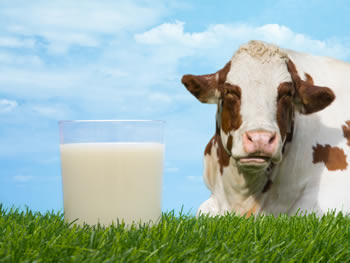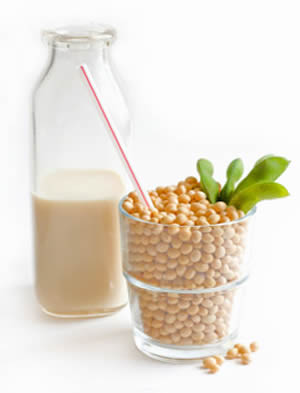Difference between Soya Milk and Normal Milk
Key Difference: Normal Milk is actually the milk from cows. However, it can also commonly be the milk of buffaloes and water buffaloes. Soya Milk, also written as soy milk, is a milk substitute that is made for soy bean. The major benefit of soy milk is that it has the same amount of protein as normal milk, but without the protein lactose. Soy milk also has little saturated fat and no cholesterol as compared to regular milk. However, regular milk has various vitamins and minerals that soy milk lacks.

Milk is a necessary part of an average day. Most people consume milk every single day of their lives without a thought. However, there are some people who cannot drink regular milk. This is mainly due to the fact that normal milk contains a protein called lactose, which some people cannot digest. This is actually a condition called lactose intolerance. Hence there are a lot of alternatives to normal milk available for these people. This includes almond milk, rice milk, coconut milk, and soya milk.
Normal Milk is actually the milk from cows. However, it can also commonly be the milk of buffaloes and water buffaloes. Some cultures also drink the milk of sheep, goats, yaks, horses, reindeer and camels, yet cow’s milk is the most popularly consumed milk in the world. In fact, there are varieties available in the cow milk as well. These include 1% milk, 2% milk, Skimmed milk, milk powder, and whole milk, among others.
Soya Milk, also written as soy milk, is a milk substitute that is made for soy bean. In order to make soy milk, the soy beans are first soaked in water, and then grinded into paste. This paste is then mixed with water and boiled for a certain amount of time. After which, the milk solution is then filtered to remove the insoluble soy milk fiber. The filtered milk is what is called soy milk.
While soy milk has recently gained popularity, it has been in existence since 200 BCE. It was first used in China, but it was not regularly consumed until the 1800s, and was introduced to the western world much later.
The major benefit of soy milk is that it has the same amount of protein as normal milk, but without the protein lactose. As previously stated, many people are not able to ingest and digest this protein. This is mainly due to the fact that they do not have the ability to produce the enzyme, lactase, which converts the lactose into glucose. Due to this, lactose intolerant people cannot drink or consume regular milk. However, they can consume soy milk, as it does not have lactose. Hence, soy milk is a popular alternative to regular milk.
 Many people also consume soy milk instead of cow’s milk, as it contains less fat than whole milk. This is also the reason that many people prefer 1% milk, 2% milk, or skimmed milk to regular milk. Soy milk also has little saturated fat and no cholesterol as compared to regular milk. However, regular milk has various vitamins and minerals that soy milk lacks.
Many people also consume soy milk instead of cow’s milk, as it contains less fat than whole milk. This is also the reason that many people prefer 1% milk, 2% milk, or skimmed milk to regular milk. Soy milk also has little saturated fat and no cholesterol as compared to regular milk. However, regular milk has various vitamins and minerals that soy milk lacks.
Soy milk is also regularly consumed due to the fact that it has a reduced ecological impact as compared to regular milk. Due to this, it is commonly consumed in a vegan diet, as vegans refrain from consuming any animal based products, due to their inhumane and exploiting production methods. Vegans claim that human take advantage of cows as cows need to be kept constantly pregnant so that they are lactating; their calves are separated from the mother almost immediately after birth, so that the milk can be used for human benefit. Also, the female calves are grown to be used in cow production, while the male calves are killed or used for veal and beef. Furthermore, once the cows cannot produce milk any longer they are killed as well.
Comparison between Soya Milk and Normal Milk:
|
|
Soya Milk |
Normal Milk |
|
Source |
Soy bean |
Cows |
|
Process |
In order to make soy milk, the soy beans are first soaked in water, and then grinded into paste. This paste is then mixed with water and boiled for a certain amount of time. After which, the milk solution is then filtered to remove the insoluble soy milk fiber. The filtered milk is what is called soy milk. |
The cows are milked to get the pure whole milk. This milk is then homogenized and pasteurized for human consumption. |
|
Types |
Sweetened, unsweetened |
1% milk, 2% milk, Skimmed milk, milk powder, and whole milk, |
|
Products |
Tofu, soy yogurt, soy cream, soy kefir and soy based cheese. Also used with tea, coffee, cereal, etc. |
Paneer, yogurt, cream, kefir, and various cheeses. Also used with tea, coffee, cereal, etc. |
|
Dates back to |
202 BCE |
9000 BCE |
Comparison of nutritional value in 1 cup milk according to United States Department of Agriculture (USDA):
|
Nutrients (1 cup) |
Soya Milk |
Cow Milk (Whole Milk) |
|
Calories |
131 kcal |
149 kcal |
|
Total Fat |
4.2 g |
7.98 g |
|
Saturated fat |
0.5 g |
4.6 g |
|
Polyunsaturated fat |
2.3 g |
0.5 g |
|
Monounsaturated fat |
1 g |
2 g |
|
Cholesterol |
0 mg |
24 mg |
|
Total Carbohydrate |
15 g |
11.66 g |
|
Dietary fiber |
1.5 g |
0 g |
|
Sugar |
9.7 g |
12.32 g |
|
Protein |
7.95 g |
7.69 g |
|
Vitamin A |
0 µg |
112 µg |
|
Vitamin C |
0 g |
0 g |
|
Vitamin D |
0 µg |
0.2 µg |
|
Vitamin B-6 |
0.187 mg |
0.088 mg |
|
Vitamin B-12 |
0 g |
1.10 g |
|
Calcium |
61 mg |
276 mg |
|
Iron |
1.56 mg |
0.07 mg |
|
Magnesium |
61 mg |
24 mg |
|
Phosphorus |
126 mg |
205 mg |
|
Potassium |
287 mg |
322 mg |
|
Sodium |
124 mg |
105 mg |
|
Zinc |
0.29 mg |
0.9 mg |
Image Courtesy: thefermentedfoody.com, mercola.com









Add new comment